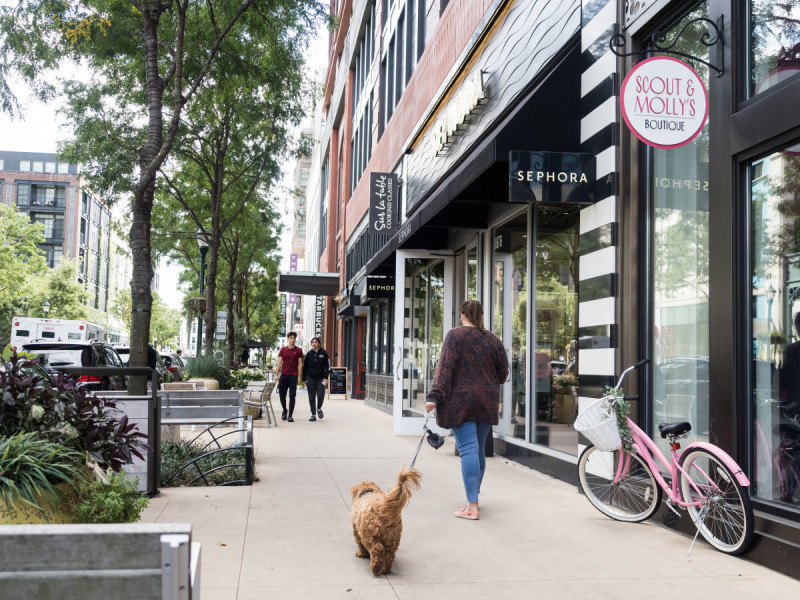We’re #WalkingHere in Montgomery County

Students walk home from school in Germantown. Photo from the Montgomery County Planning Department.
Editor’s note: GGWash periodically posts public service announcements like this directly from agency leaders and staffers when they align with our policy priorities.
Montgomery County is getting a Pedestrian Master Plan. It’s a groundbreaking, data-driven document that guides county leadership on the most effective ways to welcome more walking in a county largely shaped by the automobile. The recommended actions in the plan will help the county continue its recent pivot toward embracing walkability, prioritizing safety, connecting communities, and reimagining what a suburb can be.
Today in Montgomery County:
- 7.5% of weekday trips take place on foot, even though 20% of all trips are less than a mile
- 16% of elementary school students walk to school
- People with disabilities are markedly less satisfied with their pedestrian experience than people without disabilities
- Sidewalks along our busiest streets have the least tree canopy
- Our Equity Focus Areas are home to only 14% of the county’s roadway miles, but 44% of pedestrian severe injuries and fatalities
We can do better.
On the heels of the county’s adoption of Vision Zero in 2016 (the first county in the U.S. to do so!), the groundbreaking Bicycle Master Plan in 2018, the Complete Streets Design Guide in 2021, and the transformative Thrive Montgomery 2050 General Plan in 2022, the Pedestrian Master Plan is the first master plan in Montgomery County to make recommendations to improve the pedestrian experience in a holistic way.
A streetscape in Pike and Rose. Image by Montgomery County Planning Department.
This is not a traditional transportation master plan. The focus is not lines on a map that identify where new sidewalks should go, but the policies, practices, laws, and regulations that need to change to allow walking to flourish. After all, the pedestrian experience is about more than just sidewalks and safe crossings.
Over the past three years, Montgomery Planning team has been busy drilling down into just what the pedestrian experience in the county is. From developing innovative public engagement and data collection tools to conducting a student travel tally with Montgomery County Public Schools and a statistically valid countywide pedestrian survey, every effort was made to understand what it’s like to walk in the county and what systemic issues are present that stifle walking (and rolling).
Uneven brick pavers in downtown Silver Spring. Image by Montgomery County Planning Department.
Then, the team put together a suite of recommendations to systematically address those issues.
The Design, Policy, and Programming recommendations are the heart of the plan. This is where the big ideas, the gamechangers, and the data-driven pedestrian prioritizers live. Of the 100+ key actions in this section, these are particularly significant:
- Providing more time for younger pedestrians, older pedestrians, and those with mobility issues to cross the street safely
- Updating pedestrian pathway and intersection lighting standards
- Improving driver education, particularly for people driving vehicles with identified pedestrian safety issues
- Adopting a more proactive sidewalk construction and maintenance approach
- Increasing the number of places pedestrians can safely cross the street
- Identifying opportunities to change the streetscape to help mitigate climate impacts that affect pedestrians, such as extreme heat
- Beginning a conversation on the transfer of state highways in more urban areas and along transit corridors to county control to provide improved design flexibility and accountability
- Developing a plan to provide public restrooms countywide
- Reimagining the county’s Safe Routes to School programming
- Increasing the number of Automated Traffic Enforcement locations countywide
- Removing obstructions like utility poles from pedestrian pathways
These recommendations won’t transform the county overnight, but their implementation sets the stage for systemic improvements to the pedestrian experience. While it may take longer for these efforts to bear fruit, the results will be more impactful than one-off projects in specific locations. It’s the difference between a “Build a sidewalk here” approach where you get a single sidewalk in a deserving community and a “Make it easier to build needed sidewalks faster” approach that produces more sidewalks in more places throughout the county.
Pedestrians walk in Kemp Mill. Image by Montgomery County Planning Department.
Creating a more walkable Montgomery County where pedestrians are the priority is a long-term endeavor. The decisions that led to the current pedestrian circumstances have accumulated over the course of many decades and reflect the priorities of a different time. This plan presents a new path forward, but progress will take persistence, investment, advocacy, and political will. Pushing ahead will be the work of community members, public employees, private developers, and elected officials.
The plan’s Planning Board Public Hearing will take place March 23 at 6pm. If you have an interest in walking in Montgomery County, please feel free to review the Public Hearing Draft Plan and submit written testimony or sign up to testify in-person or virtually.
We are all walking here.
